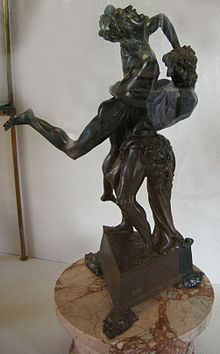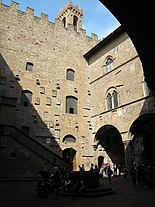Bargello


TheBargello,also known as thePalazzo del BargelloorPalazzo del Popolo( "Palace of the People" ), is a formerbarracksand prison inFlorence,Italy.Since 1865, it has housed theMuseo Nazionale del Bargello,a national art museum.
Terminology
[edit]The wordbargelloappears to come from the lateLatinbargillus(fromGothicbargiand Germanburg), meaning "castle" or "fortified tower". During the ItalianMiddle Agesit was the name given to a military captain in charge of keeping peace and justice (hence "Captain of justice" ) during riots and uproars. In Florence he was usually hired from a foreign city to prevent any appearance of favoritism on the part of the Captain. The position could be compared with that of a current Chief of police. The name Bargello was extended to the building which was the office of the captain.
The palace
[edit]

Construction began in 1255. The palace was built to house first theCapitano del Popoloand later, in 1261, the 'podestà', the highest magistrate of the FlorenceCity Council.This Palazzo del Podestà, as it was originally called, is the oldest public building in Florence. This austere crenellated building served as model for the construction of thePalazzo Vecchio.In 1574, theMedicidispensed with the function of thePodestàand housed thebargello,the police chief of Florence, in this building, hence its name.[1]It was employed as a prison; executions took place in the Bargello's yard until they were abolished by Grand DukePeter Leopoldin 1786, but it remained the headquarters of the Florentine police until 1859. When Leopold II, Holy Roman Emperor Peter Leopold was exiled, the makeshift Governor of Tuscany decided that the Bargello should no longer be a jail, and it then became a national museum.
The original two-story structure was built alongside the Volognana Tower in 1256. The third storey, which can be identified by the smaller blocks used to construct it, was added after the fire of 1323. The building is designed around an open courtyard with an external staircase leading to the second floor. An open well is found in the centre of the courtyard.[1]
The Bargello opened as a national museum (Museo Nazionale del Bargello) in 1865,[1]displaying the largest Italian collection ofgothicandRenaissancesculptures (14–17th century).
Art collection
[edit]The museum houses masterpieces byMichelangelo,such as hisBacchus,Pitti Tondo(orMadonna and Child),BrutusandDavid-Apollo.[2]Its collection includesDonatello'sDavid,Amore-AttisandSt. George Tabernacle,[3]Vincenzo Gemito'sPescatore( "fisherboy" ),[4]Jacopo Sansovino'sBacchus,[2]Giambologna'sArchitecture[5]and hisMercury[2]and many works from theDella Robbiafamily.[3][6][7][8]Benvenuto Celliniis represented with his bronze bust of Cosimo I.[2]There are a few works from the Baroque period, notablyGianlorenzo Bernini's 1636-7Bust of Costanza Bonarelli.
The museum also has a fine collection of ceramics (maiolica), textile, tapestries, ivory, silver,armourand coins. The formerly lost right-hand panel of theFranks Casketis held by the museum. It also features the competing designs forThe Sacrifice of Isaac(Sacrificio di Isacco) that were made byLorenzo Ghiberti[3]andFilippo Brunelleschi[3]to win the contest for the second set of doors of theFlorence Baptistery(1401).
Honolulu Hale's interior courtyard, staircase, and open ceiling were modeled after the Bargello.[9]
The Islamic Hall at the Bargello was set up in 1982 byMarco SpallanzaniandGiovanni Curatolaat the direction ofPaola BarocchiandGiovanna Gaeta Bertelà,then the director.[10]
Gallery
[edit]-
Lorenzo Ghiberti'sIsaac's Sacrifice.
-
Bust(attributed to Donatello)
-
Bust of Christ,(Tullio Lombardo).
-
Bust of Pietro Melllini(Benedetto da Maiano).
-
Coronation ofFerdinand II of Aragon.
-
Musicians from program for Coronation of Ferdinand II,(Benedetto da Maiano).
-
Anghiari Battle,Giovan Francesco Rusticiafter Leonardo da Vinci
-
Madonna di Santa Maria Nuova-Luca della Robbia
-
Crucifixattributed to Michelangelo.
-
Empress Ariane(Byzantine).
-
St George,(Donatello).
-
David,(Donatello).
-
Architettura,(Giambologna).
-
Il Pescatorello(little fisher boy),Vincenzo Gemito
-
Aquamanile representing St George and his horse (Mosane or Rhine region - ca. 1400-1410).
See also
[edit]References
[edit]- ^abcZucconi, Guido (1995).Florence: An Architectural Guide(November 2001 Reprint ed.). San Giovanni Lupatoto, Verona, Italy: Arsenale Editrice. p. 38.ISBN88-7743-147-4.
- ^abcd"Sala di Michelangelo e della scultura del Cinquecento".Bargello National Museum.Ministry of Cultural Heritage. Archived fromthe originalon June 6, 2006.RetrievedJuly 24,2006.
- ^abcd"Salone di Donatello e della Scultura del Quattrocento".Bargello National Museum.Ministry of Cultural Heritage. Archived fromthe originalon June 6, 2006.RetrievedJuly 24,2006.
- ^"Il Cortile".Bargello National Museum.Ministry of Cultural Heritage. Archived fromthe originalon June 6, 2006.RetrievedJuly 24,2006.
- ^"Verone".Bargello National Museum.Ministry of Cultural Heritage. Archived fromthe originalon June 6, 2006.RetrievedJuly 24,2006.
- ^"Cappella di Maria Maddalena e Sagrestia".Bargello National Museum.Ministry of Cultural Heritage. Archived fromthe originalon June 6, 2006.RetrievedJuly 24,2006.
- ^"Sala di Giovanni della Robbia".Bargello National Museum.Ministry of Cultural Heritage. Archived fromthe originalon June 6, 2006.RetrievedJuly 24,2006.
- ^"Sala di Andrea della Robbia".Bargello National Museum.Ministry of Cultural Heritage. Archived fromthe originalon June 6, 2006.RetrievedJuly 24,2006.
- ^"Historic Honolulu (The Capitol District)".City and County of Honolulu.October 10, 2003. Archived fromthe originalon November 19, 2004.RetrievedJuly 24,2006.
- ^"A Firenze in mostra l'arte islamica – TgTourism".tgtourism.tv(in Italian).Retrieved2018-10-06.
External links
[edit]- "Bargello National Museum".Ministry of Cultural Heritage. Archived fromthe originalon 13 September 2016.Retrieved14 August2016.


















